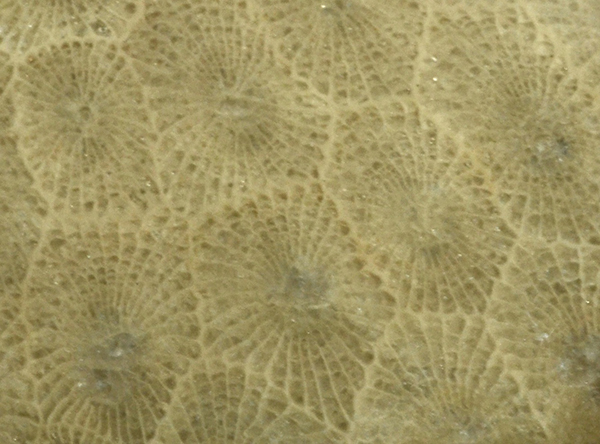
by Jay R. Thompson Wednesday, July 4, 2012

A close-up of the coral structure fossilized in Petoskey stones. Though the stones are found in the northern part of Michigan's Lower Peninsula, the coral lived in a warm shallow sea near the equator 350 million years ago. Plate tectonics have since moved Michigan about halfway to the North Pole and lifted the region above sea level. Jay R. Thompson
Around the Fourth of July, I usually visit my parents and participate in a geological family tradition that is pointless to the extreme and yet addictive and fun. Mom and Dad live on Lake Leelanau near Traverse City, Mich. The lake is about a dozen kilometers long and a few kilometers wide. It’s a great place for water-skiing, fishing, jet-skiing and kayaking. We do some of those things, but we also wade along the shore behind my parents’ house and search for Petoskey stones, the state stone of Michigan.
The shore is rocky, and rounded rocks about the size of a fist blanket the lake bottom near water’s edge. We can spend more than an hour at a stretch, hunched over and slowly walking back and forth where the water meets the pebbly shoreline to find a good Petoskey stone. Generally, we find a Petoskey stone every few minutes if we’re willing to overturn a few stones and ignore the tiny leeches clinging to them.
But what we really want is a better stone. Looking for Petoskey stones is like watching for shooting stars — every time to you see one, all you want is to keep watching until you see a better one. With Petoskey stones, we’re looking for one with clear honeycombing and minimal intrusion of clay or other minerals. When you find a good one, you must show it to anyone else nearby. They say “Ooooh, that’s a good one.” Then you go back to looking for better stones.
I’ve been finding Petoskey stones as long as I can remember but, as much as I hate to admit it, I’ve never learned much about them. I don’t know how old they are, how widespread they are, or how they ended up where they are. I simply assumed there was once an ocean covering that part of North America, but I never looked into it. Fortunately, the Michigan Department of Environmental Quality’s Geological Survey Division (pdf) kindly assembled a Petoskey stone factsheet to clear up this knowledge gap.
The Petoskey stone is the remnants of a fossil colony coral called Hexagonaria percarinata that lived during the Devonian. (Curiously, most descriptions describe the coral in Petoskey stones as both dating to the Devonian period and being about 350 million years old despite the conventionally accepted end date for the Devonian at 359 million years ago.) During the Devonian, Michigan was covered in a warm shallow sea and was near the equator — a good environment for coral to flourish. Then Earth’s plates moved, leaving Michigan straddling the 45th parallel. The movement of tectonic plates also caused the lifting of Michigan above sea level. Then, about 2 million years ago, glaciers scraped Petoskeys from the bedrock and deposited them in what is now Lake Leelanau, as well as lots of other places.
No less than seven species of coral within the genus Hexagonaria are found in Michigan’s Devonian rocks. Some of those species are also found in other Midwestern states, as well as in Asia, England and Germany. If you want a close-up look at a Petoskey stone, you can find polished ones in shops in Traverse City and all over Michigan. The stones are primarily calcite, so they’re soft enough to be easily sanded, polished and sold as pendants, earrings, doorknobs, paperweights and everything else you can imagine.
However, if you’re ever in Michigan, I suggest you skip the souvenir shop, at least at first, and go searching for the stones yourself. It’ll be the easiest paleontological expedition you’ll ever participate in. All you need is to roll up your pants and wander in the rocky shallows of a small Michigan lake, and you’ll easily find a fossil from the time before mammals, birds, insects, and even reptiles walked the planet. (Be sure, of course, to avoid trespassing or illegally collecting fossils!)
© 2008-2021. All rights reserved. Any copying, redistribution or retransmission of any of the contents of this service without the expressed written permission of the American Geosciences Institute is expressly prohibited. Click here for all copyright requests.